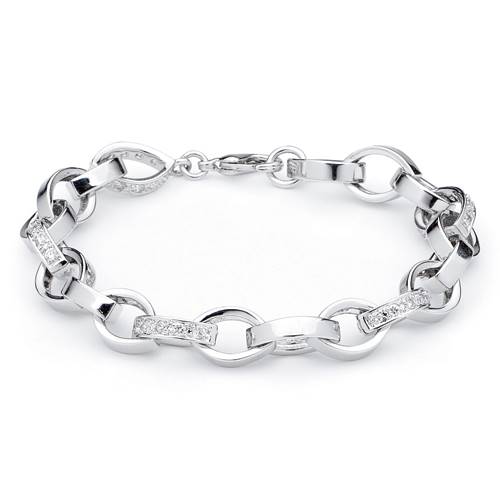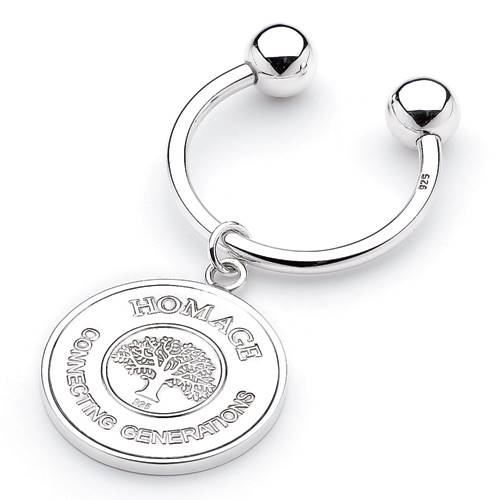White metal jewellery is hot
 43.7 k views | By Naomi Levin
43.7 k views | By Naomi Levin
Can white metal jewellery get any hotter next year? Naomi Levin explores what the 2012 trends will be and why the ‘whites’ will get even more popular.
Iconic British fashion designer Vivienne Westwood is best known for her punk styles: the tartan, the safety pins and the black and red colouring.
While early in her career she took a course in silversmithing, her famous name is not usually associated with fine jewellery, so it was a surprise to style gurus at London Fashion Week when she launched a range of palladium jewellery earlier this year.
Westwood teamed up with the Palladium Alliance to create a collection called Get a Life, featuring quirky heart-shaped pendants and a range of nature-inspired pieces – an unsurprising choice from the keen gardener. Endorsing the palladium pieces was one of television’s hottest stars, Mad Men’s flame-haired beauty Christina Hendricks.
With palladium described as “tough”, “sexy” and great for sensitive skin by the Alliance, it is no wonder it and other white metals are capturing customers’ attention.
For a long time now, Australian jewellers have noticed a growing demand for white metals – stainless steel, silver, white gold, platinum and increasingly, titanium and palladium. White metals are seen as modern, clean, easy to “work” and more avant-garde than traditional yellow gold, especially among younger buyers. Economics are also shifting in favour of white metals. With the price of gold and, to a lesser extent, platinum going through the roof, jewellers are favouring silver, stainless steel and titanium as their metal of choice. As the name suggests, Stones and Silver is a brand that creates its jewellery pieces from silver and gems. Director Alex Bonnet explains: “It’s what we started on, it’s what we know and what we enjoy working with.” Asked whether the company uses any other metal, he replies, We’ve dabbled, but silver is 99.9 per cent of our work.”
Versatile silver
The versatility of silver means that it is the design, rather than the material, that catches the eye. Whether dressed up with pearls and precious stones, or dressed down with coral and shell, the pieces are equally striking.
“Silver suits the iconic Australian,” Bonnet says. “It is understated, it blends with the lifestyle and fashion and it is not over the top. Bonnet added that different people tend to look for “something simple and subtle, or a ‘wow’ piece, and silver is a beautiful metal for both”. Beauty is one thing, but being easy to manipulate is also a big plus in favour of sterling silver. Bunny Bedi of Made in Earth Creations began using the metal after finding it an easy material to mould around the company’s abstract and striking stones. “Certainly in the beginning the low price of silver was a determining factor, as well as how it worked visually with the coloured gemstones that appealed to the new age market,” Bedi says. “Today, even with the huge rise in silver prices, we have continued to set our stones with silver.”
Bedi also agrees with Bonnet that silver suits Australians well: “Even though gold is part of the Australian heritage, it is not particularly viewed as a sign of wealth. Unlike countries, like India, Italy and China, where gold is viewed as more of a sign of wealth and opulence, Australia is a relatively young country, and perhaps doesn’t have the same association.”
The diverse nature of sterling silver can be seen through its incorporation in Thomas Sabo pieces. In stark contrast to the natural, curved, organic forms of Made in Earth Creations and Stones and Silver, Thomas Sabo’s lines are clean, precise and sleek. Whether it is the Classic collection’, the Charm Club or even its Rebel at Heart range, Thomas Sabo’s use of sterling silver shows off the crispness of the metal. Using silver, according to Philip Edwards, director of Sabo’s Aussie distributor Duraflex, has become a trademark for the brand.
“Mr Sabo started the business with sterling silver as he simply preferred the material and the look of sterling silver jewellery,” Edwards explains, adding, “Sterling silver has now become a key feature, identity and core component of the brand that will not be changed, and gold will never be added to the story. The whole brand identity for Thomas Sabo is based on sterling silver,” he says. The German-brand clearly has plenty of success with sterling silver and with white metals currently in high demand. Looking ahead, will this always be the case?

Georgini
“I feel this current positive demand and trend for white metal will only continue to grow and become stronger over the next few years,” Edwards predicts.
Others are not as convinced that white metals will continue to dominate the jewellery industry as it is doing now. Homage-Personalised Jewellery is currently available in silver, all colours of gold, platinum and titanium. Bella Kennedy, director of Iconic Jewellery, which distributes Homage, was surprised at how well customers received the gold range of personalised jewellery. “Before we released our gold, I would have said the price point [would have been a barrier], but since we have released our gold, we have had nearly as many orders in gold as silver,” she says. Asked whether she thinks yellow gold is preparing to make a comeback, Kennedy replies: “I think it depends on the item. There are still faithful gold buyers out there that won’t buy anything but gold.”
An age thing
It’s no fluke that white metals will remain popular with the younger market, who have less disposable income and are more price sensitive. It seems however, that while older generations have grown up with gold, they are not averse to trying something different also.
“I think the current fashion trend with sterling silver is for all age markets and categories – there is certainly no defined young age category for sterling silver,” Edwards says. “Yes, I feel gold may be considered a more ‘mature person market’, but the current significant increase in the actual gold price makes gold products more expensive and potentially out of reach for the younger market.”
Because of the price, branding and design of white metals, Edwards adds, older markets will continue to be attracted to sterling silver.
Pastiche, designer Laurian Ryan agrees there is a perception that white metals are more popular among the younger age groups, but says customers across the generations are seeing the beauty in diversity. “Gold jewellery is appealing to a wider range of ages, as designs continue to evolve and as bolder statement pieces are being created using metals, such as stainless steel plated in gold,” Ryan notes. “By the same token, older markets are not locked into purchasing gold jewellery, even if this is the majority of the jewellery they already own. This is because we are seeing the practice of mixing metals.”
The growing trend for jewellery wearers to mix metals, colours and styles is being reflected in Pastiche’s latest women’s collections, which are all stainless-steel based. “The steel is ion-plated in an array of colours – from black and gunmetal grey, to chocolate and yellow and rose gold,” Ryan describes. “The ion-plating technique ensures lasting and lustrous colour so it has the same look and feel of rose and yellow gold without the heavy price tag. This material has the added benefit of being harder wearing and more tarnish resistant than gold.”
While white metals’ structural and aesthetic qualities are clearly driving the trend, one would be negligent to discount the effects of prominent economic factors also.
Economic factors
Ryan says jewellery manufacturers are trending toward smaller pieces with cut-out patterns to reduce the amount of metal in their product, rather than changing the materials. Meanwhile, Bedi admits the collection began, and has remained, a silver-based range because of the metal’s relative affordability. While the price of silver reached a 30-year high of $US48.58 ($AUD46.95) earlier this year, the price of gold is predicted to hit $US2000 ($AUD1,933) an ounce by the end of the year – a cost that is putting the age-old precious material out of the reach of many people.
The rush on commodities – brought about by global economic instability, which is encouraging investors to look for tangible assets to put their money into – is certainly affecting Chris Worth’s Worth and Douglas fashion collection. “With the rising metal prices we have seen a big jump in silver sales, with both economical and fashion-conscious shoppers deciding to purchase their latest fashion jewellery in sterling silver,” Worth says.

Homage
Nils Rasmussen, representing Skagen Denmark, said the brand only works with stainless steel, a material often better associated with men’s jewellery, does not scratch or tarnish, looks great and is long lasting. Rasmussen explains that producing pieces in stainless steel is also cheaper and not subject to the same wide fluctuations in raw material prices as precious metals; however, Iconic Jewellery’s Kennedy notes that metal prices are not generally a consideration among the wealthier customers in Homage-Personalised Jewellery’s target audience.
Australia’s love affair with white metals looks set to continue. Top fashion houses are using palladium as their metal of choice – designers enjoy its versatility, the price is right and, most importantly, customers just love it.
A real white wedding
Every girl dreams of a white wedding, but it seems these days, white extends further than just the bridal dress. Flick through the pages of any Australian wedding magazine and you will notice that just about every bride (and groom) is wearing a white metal engagement and wedding ring. Continuing the theme, wedding jewellery – earrings, tiaras, cuff links and necklaces – are almost exclusively in white metals.
Georgini’s Gina Kougias says the craze is being driven by a desire to follow up-to-the-minute fashion. “When I was married, over 27 years ago, it was yellow gold that was in fashion,” Kougias points out. Georgini’s bridal range, which consists of delicate cubic zirconia tennis bracelets, vintage-style earrings and pearl pendants, is set exclusively in sterling silver – not a hint of yellow or rose gold in sight. Worth and Douglas, another significant supplier to the bridal market, is also supplying the demand for white metals on the big day, but sometimes tradition wins out. The manufacturer is well-known for its wedding bands, and Chris Worth explains, “White gold is still the most popular of the white metals, but there are still a lot of people who wouldn’t buy anything other than the traditional yellow gold wedding band. There has been a noticeable increase in demand for white metals over the last decade, especially as other alternative white metals, such as palladium and titanium, become more widely known,” he says.
According to Worth, yellow gold is a relic of the past for many couples. Soon-to-be weds pick white gold, silver, palladium or titanium for a “more modern and sophisticated” feel. “We still sell more yellow gold ladies wedding rings,” Worth says, “but white is certainly the more popular choice for men, as it offers a casual look, looks good against all skin tones and matches up well with stainless steel watches.” He notes the increasing popularity of state-of-the-art, light-weight titanium and palladium wedders, particularly among Muslim men who are forbidden by their religion from wearing gold. White metals are also hugely popular when set with a girl’s best friend.
“When designing diamond jewellery, we often to tend to go white because you really want to show off the diamonds,” Worth says. “The end result with white metals, especially platinum, is very satisfying, although it requires extra labour. White gold or platinum set with high-grade white diamonds just looks superb.” The verdict seems clear – to capture the all important wedding market, forget yellow and forget rose; newlyweds will be wanting to be wed in white.
More reading:
Jewellery retail's must-stock trends
Urban metals gain stronghold
The rise of silver
Posted October 31, 2011